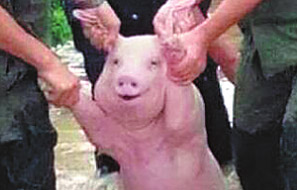Rare native fish bred, tagged and released in Tibet
Fishery scientists have released tagged fish into a river for the first time in the Tibet autonomous region so they can better monitor the population of three rare species.
Some 470 tagged fish were released into the Lhasa River in August, said Liu Haiping, an associate professor at the Fishery Research Laboratory of the Tibet Academy of Agricultural and Animal Husbandry Sciences.
"We have been cultivating and releasing fish into rivers to replenish stocks since 2004, but we haven't done research before - because of the lack of money and equipment - to assess the effect of artificial breeding and release," he said.
"This is the first time that we have used marking and tagging methods for fish releases in Tibet. The methods have already been used in other places around China, but the situation might be different here."
Liu said the 470 released fish include three rare species related to carp that are native to Tibet.
"The populations of the three species have been declining in recent years because they are vulnerable to invasive species and habitat destruction, and individual fish are becoming smaller," said Liu, adding that it's urgent to protect and restore fish stocks.
The Lhasa River was chosen for the releases because it is the natural home of the three species and it is also close to downtown Lhasa, Tibet's capital, where technological support is available.
The fish were bred in the laboratory for their ability to survive. Length varies from 15 to 25 centimeters.
Each fish is marked by a fluorescent marker over its head, and also has a small T-shaped plastic tag inserted into the muscle on its back, according to Zhu Tingbing, a researcher from the Yangtze River Fisheries Research Institute. The tag has a unique identification code that sticks out of the fish's body and includes data about it.
"Each marking method has its own advantage. Fluorescent labeling does less damage to the fish than T-style tagging, but it disappears easily. When that happens, we can't identify an individual fish," Zhu said, adding that both marking methods may be used at the same time for the purpose of comparing their results and figuring out which works better in Tibet.
"The higher the recapture rate is, the more reliable the research data will be," Liu said. "Time and place should be taken into consideration when we start to catch the labeled fish."
The recapturing period will last for a year from the release day.
"We are going to catch the fish once a week within the first month, and then once a month after the first month," he said.
Liu said the recapture area is a 20-kilometer river segment that extends both upstream and downstream from the release site. The migration distance of the three rare species is short, he said.
Various factors can influence the recapture rate, including the type and size of the fish, water quality of the river and human interference. Liu feels optimistic about the survival rate.
"After recapturing, we are going to identify the fish type, measure its size, and evaluate its growth and migration pattern," Zhu said.
"Tagged releases can help assess the effect of the artificially bred fish being released into the Lhasa River. I hope we can use the experience gained to carry out further research and gradually promote it to other parts of Tibet."
Zhang Yi contributed to this story.






















